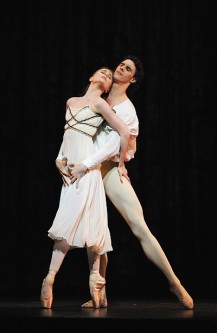 United Kingdom Prokofiev, Romeo and Juliet: Birmingham Royal Ballet, Royal Ballet Sinfonia, Koen Kessels (conductor, Birmingham Hippodrome, 24.2.2016. (GR)
United Kingdom Prokofiev, Romeo and Juliet: Birmingham Royal Ballet, Royal Ballet Sinfonia, Koen Kessels (conductor, Birmingham Hippodrome, 24.2.2016. (GR)

(c) Roy Smiljanic
Principal Dancers:
Julie: Jenna Roberts
Romeo: Iain Mackay
Mercutio: Mathias Dingman
Tybalt: Tyrone Singleton
Benvolio: Yasuo Atsuji
Paris: Steven Monteith
Production:
Choreography: Kenneth MacMillan
Designs: Paul Andrews
Lighting: John B. Read
Rehearsed by Desmond Kelly
After the pleasantries of last week’s The Dream, Birmingham Royal Ballet continued the West Midlands’ Our Shakespeare celebrations at their Hippodrome home with a contrasting ballet adaptation – Romeo and Juliet, one of the bard’s tragedies that has attracted more choreographers than any other Shakespearean drama. It has been made a classic in that genre by Kenneth MacMillan. On 24th Feb 2016 a full house was buzzing with anticipation – and they were not disappointed.
What makes this such a perennial favourite for me and with audiences is the music of Prokofiev. Celebrated for his wide variety of styles from the classical to the grotesque, with Romeo and Juliet he placed the lyric at the heart of a magisterial score, toeing the official Soviet party line in the late 1930s. The composer achieved a dramatic narrative structure through Leitmotif, for both major characters and demonstrative ideas, brilliantly varying rhythm, harmonics and melody to suit the state of play. All this was thrillingly put across on the first night by Koen Kessels and the Royal Ballet Sinfonia. Although the beautiful opening melody is interspersed with the odd clash of semitone, the Sinfonia rightly gives no hint of the enmity to come between the Montagues and the Capulets. This feeling is reinforced by the bassoon that amusingly introduces Romeo and his two mates enjoying the folk dance music and intent upon a good time in the Verona market place. Only when Escalus begins to try and placate the street fracas that ensue by insisting arms are laid down, is a shattering dissonance heard (known as ‘The Duke’s Orders’), the first musical hint of the portentous tragedy to come. The Sinfonia strings (superbly led as ever by Robert Gibbs) play their part in the early lyricism of Prokofiev, friskily joining in as we share Juliet’s carefree teasing of Nurse. And as the invited guests of the Capulets strut around the stage in all their pomp, Kessels produces a stirring ‘Dance of the Knights’. (No apprentices in the Hippodrome pit!). The sounds that accompany the fight scenes were as motoric and electrifying as the action itself, while the building of tension in the final act inspirational.
Although the Kenneth MacMillan choreography dates from 1965 with designs by Nicolas Georgiadis, this BRB production first staged in 1992, features the designs of Paul Andrews. His architecture is most impressive and the Raphaelesque colourings look stunning in the lighting of John B. Read. Particularly discernible are the costumes of the nobility and the BRB corps dancers. But top marks go to the three harlots with their dazzling plumage-crowned headgear. Indeed the dancing and antics of these good-time girls (the effervescent Céline Gittins, Yvette Knight and Angela Paul) are a highlight of the show; they are excellent foils for the three leading Montague studs in the opening scene, looking for a bit of spare. Group scenes are consistently strong and the intricacies of movement during the Mandolin Dance was amazingly collision-free, doubtlessly due in no small part by the rehearsals of Desmond Kelly.
Of the principal dancers, Jenna Roberts as Juliet came across as the innocent 13-year-old, initially a giggly child playing with her dolls, before awakening into a starry-eyed teenager who encounters love for the first time. On the enchanted evening of the Capulet Ball (and across a crowded room) while dancing with Paris her arranged intended, Juliet sets eyes on a masked gate-crasher: wonder and yearning abound for Romeo. For the balcony scene, Roberts lets her hair down both literally and figuratively, revealing her love to be ‘as boundless as the sea’. Iain Mackay is the object of her instant fascination; his response is positive and while demonstrating much athletic prowess, I thought his reaction no more intense that that he had previously given to one of the harlots – no unbridled Latin passion that the occasion demands. Their subsequent pas de deux featured some impressive leaps from Roberts into the arms of Mackay, yet for all their technical nous, sheer animal magnetism is lacking. They do however prove at the close of the balcony scene that ‘parting is such sweet sorrow’. As Tybalt, Juliet’s cousin and the villain of the piece, Tyrone Singleton oozed malevolent stage presence; wanting to keep his house in order; his hatred of the Montagues is as sweeping as the blades he flashes about. The Mercutio of Mathias Dingman was another unqualified success: his sword fight with Singleton is a fencing duo worthy of Errol Flynn at his best. This third scene of Act II with its two sword fights is a cracker in this BRB version: Tybalt reveals his colours by stabbing Mercutio in the back, before Romeo avenges his friend’s death by wearing down his adversary, proving he is ‘fortune’s fool’. Yasuo Atsuji as Benvolio, the third member of the Montague dynamic trio, albeit a lesser role, also dances his part well. Steven Monteith is a cool Paris, more the boy next door than a prince to start a war. Marion Tait fulfils yet another great character role as Nurse: the way she draws her ward’s attention away from her comforter-doll and to make her become aware of her blossoming sexuality, is charming, a word that summarises this show.
A Romeo and Juliet with much to enjoy. Next week BRB begin their 2016 Spring Tour, visiting the Lowry, Sunderland Empire and the two Theatre Royals of Nottingham and Plymouth.
Geoff Read